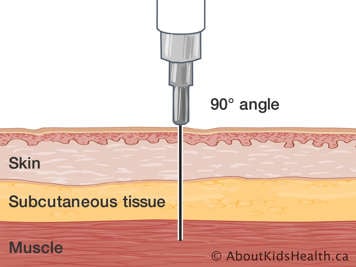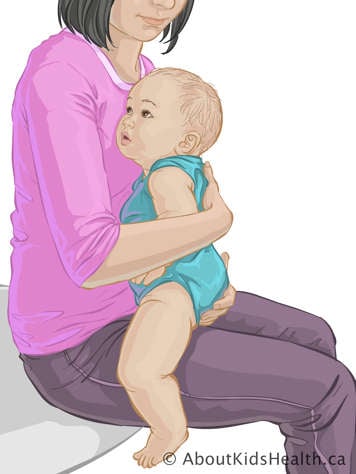
What are intramuscular injections?
An intramuscular (IM) injection is a medicine that is injected into the muscle. Medicine can also be given into the skin (intradermal), just below the skin (subcutaneous) or into a vein (intravenous).
Getting your child comfortable with needles
Children take their cues from their parents. Any fear or dislike you have of needles may make your child afraid too. Some parents find that reminding themselves that the injection allows their child to stay healthy makes injection time easier. For example, if parents say, "I need to give your injection so you will have lots of energy to play and to grow," the child begins to understand. Follow up each injection with positive words (e.g., “you did so well!”) and comfort measures.
Who should give the injection?
In many families, one person takes on most of the responsibilities for injections. However, there may be problems when that person is not there. It is important for all regular caregivers to share the responsibility of giving the injection. It is ideal for your child to feel safe and confident with more than one caregiver. Families with only one caregiver should try to seek the help of a friend or relative. Strategies for support models could include creating a schedule (i.e., one caregiver might take care of the morning injection and the other caregiver looks after the evening injection). Sharing the burden is a good coping strategy to deal with the daily demands of your child's condition and to prevent caregiver burnout.
Injection sites and needle sizes
The injection site depends on your child's age. The length of the needle also influences the location of the injection site. The length of the needle depends on the weight of your child and the type of medication they are taking.
The diameter of the needles also varies depending on your child's age. This size is described in units called "gauge numbers". Needles with larger diameters have smaller gauge numbers. Make a note on your phone or write down the following information:
The length of the needle is ________.
You child's injection site is ________.
The needle gauge number is ________.
f the injection you are giving is more than 1 mL in volume, check with your child’s health-care provider about which location is appropriate for your child.
Infants under one month
For newborns, the IM injection site is the front outer side of the thigh. To inject into the thigh, the needle length must be 16 mm. Use a 25 to 27-gauge needle.

Infants (one to 12 months of age)
For infants, the IM injection site is the front outer side of the thigh. Do not use the inner thigh or back of the thigh. Divide the thigh into thirds; the injection site is in the middle third section.
To inject into the site, the needles must be 16mm to 25 mm long. Use a 25-gauge needle. Your baby's health-care provider may give you a longer needle depending on the size of your child. The needle must be long enough so that it will reach deep into the muscle. It should reach past the tissue just above the muscle, which is the subcutaneous (SC) tissue. This helps to reduce irritation to the SC tissue which can cause pain associated with IM injections.
Toddler/walking child (one to two years of age)
For toddlers, use 22- to 25-gauge needles. There are two possible injection sites:
- Deltoid muscle: This is the top, upper part of the arm. Only inject in this site if your health-care provider tells you that this is an appropriate injection site for your child. To inject into the deltoid, the needle length must be 16 mm. However, needle lengths from 22 mm to 25 mm can be used for older children: The nurse or doctor will advise which needle size is appropriate for your child. Only give injections that are less than 0.5 mL into the deltoid.
- Front, outer side of the thigh. Do not use the inner thigh or back of the thigh. Divide the thigh into thirds; the injection site is in the middle third section.
You may be given a longer needle depending on the size of your child. The needle must be long enough so that it will reach deep into the muscle. It should reach past the tissue just above the muscle, which is the subcutaneous (SC) tissue. This helps to reduce irritation to the SC tissue which can cause pain associated with IM injections.

Children (three to 18 years)
For all children ages three and older, use 22- to 25-gauge needles. There are two possible injection sites:
- Deltoid muscle: This is the top, upper part of the arm. The nurse or doctor will advise which needle length is appropriate for your child. To inject into the deltoid, the needle length must be 16 mm. However, needle lengths from 22 mm to 38 mm can be used for older children. Only give injections that are less than 0.5 mL into the deltoid.
- Thigh: The middle of the front outer side of the thigh. Do not use the inner thigh or back of the thigh. Divide the thigh into thirds; the injection site is in the middle third section. To inject into the thigh, the needle length must be at least 16 mm long but may need to be longer depending on your child's size.
For older children, the size of the needle depends on the sex and weight of your child. Generally, a needle that is 25 mm to 38 mm long can be used for adolescents.
- Use 25 mm needles for females who weigh over 60 kg and males up to 118 kg.
- Use 38 mm needles for females who weigh over 90 kg and males over 118 kg.
Giving an IM injection
You will need:
- a cotton ball
- soap and water to cleanse the skin
- the vial of medication (check the date on the medication vial to make sure it has not expired)
- a container to throw away the needles (this can be a thick, plastic bottle or a sharps container with a lid)
When giving your child the injection:
-

Choose the injection spot and draw up the medication into the syringe. Clean the skin with soap and water (you do not need to use an alcohol swab) and pat dry. Try to change injection sites with each injection you give. For example, inject into the left thigh in the morning and the right thigh at night.
-

Hold the syringe in a dart-like fashion. Hold the muscle around the area so that it is stable and secure. Insert the needle directly through the skin at a right angle (90-degree angle) into the muscle. Try to do this quickly.
-

Move your hand into position to direct the plunger. Do not move the needle tip once it is inserted.
-
Give the medication quickly to reduce pain, firmly pushing the plunger down as far as it will go. Do not pull back on the plunger before pushing the plunger down.
-
Pull the needle out gently at the same angle you put it in.
-

Apply firm pressure with a cotton ball to the injection site for 30 seconds after each injection to reduce the chance of bruising. Do not rub the area as it may irritate the skin.
-
Put the needle and syringe in a thick, plastic bottle or sharps container with a lid. For safety, do not try to put the cap back on the needle. When the container is full, bring it to your local pharmacy and they can safely dispose of it for you. Do not put it in your regular garbage.
What does it mean if there is bruising at the injection site?
This can happen from time to time. It is not harmful. It usually means the needle has nicked a tiny blood vessel. To reduce the chance of bruising, apply gentle pressure to the site with a dry piece of cotton or a clean finger after injecting. Also, remember not to insert the needle too slowly. If you have too much bruising, consult your child’s health-care team.
What would happen if an air bubble was accidentally injected into your child?
It is not harmful to inject an air bubble under the skin. However, you should make sure that the full volume of medicine is injected.
How to make injections less painful for your child
Medicines
- Topical anesthetic agents (EMLA, lidocaine, tetracaine) can be applied before giving the injection. Follow the directions on the packet. Your child’s pharmacist or nurse can tell you how long to apply these agents on your child's injection site prior to injection.
- Sugar mixture (oral sucrose 24%) - You can make this at home by mixing one packet of sugar to two teaspoons of water. Place a few drops of the mixture onto your baby's tongue, a few minutes before the injection. Give a few drops right as you are giving the injection. This will make it less painful for your baby. You do not need to give all of the sucrose mixture to the baby. This works in children up to 18 months of age.
Distraction
Babies can be distracted with colourful toys, mobiles and mirrors. Younger children can be distracted with blowing bubbles or party blowers, reading a favourite book, playing with a musical toy or with the use of virtual reality glasses. Older children can choose what they wish to be distracted with: a hand-held video game, a book or music.
Imagery and relaxation
Ask your child to try to imagine a pleasant experience. As your child focuses on something other than the pain, ask them to describe it using all their senses. Your child can also pick an image that feels relaxing to them. You can also suggest other sensations such as sound, smell, taste and touch that go with the situation. You may suggest that as they breathe steadily in and out, they are blowing away the tension in their muscles.
Reducing pain for babies and toddlers

- Straddle your baby on your lap so that they are facing you and their limbs on are on each side of you. This is similar to giving your child a "bear-hug". This position is easy to do when there are two people present. The other person can inject on one of the injection sites as you securely hold your baby in place. If you are alone, you can swaddle your baby in a blanket, leaving the limb out for injection.
- Breastfeeding is a good time to give your baby an injection. This will make the injection less painful. This works when there is a second person available to give the injection while your child is feeding.
- Let your child suck on a pacifier during the injection. Many toddlers and babies find this soothing and feel less pain during the injection. You can also dip the pacifier in the sugar mixture described above.
When to call a health-care provider
Call your child's health-care provider if your child experiences:
- fever or chills
- swelling or redness at the injection site that does not go away